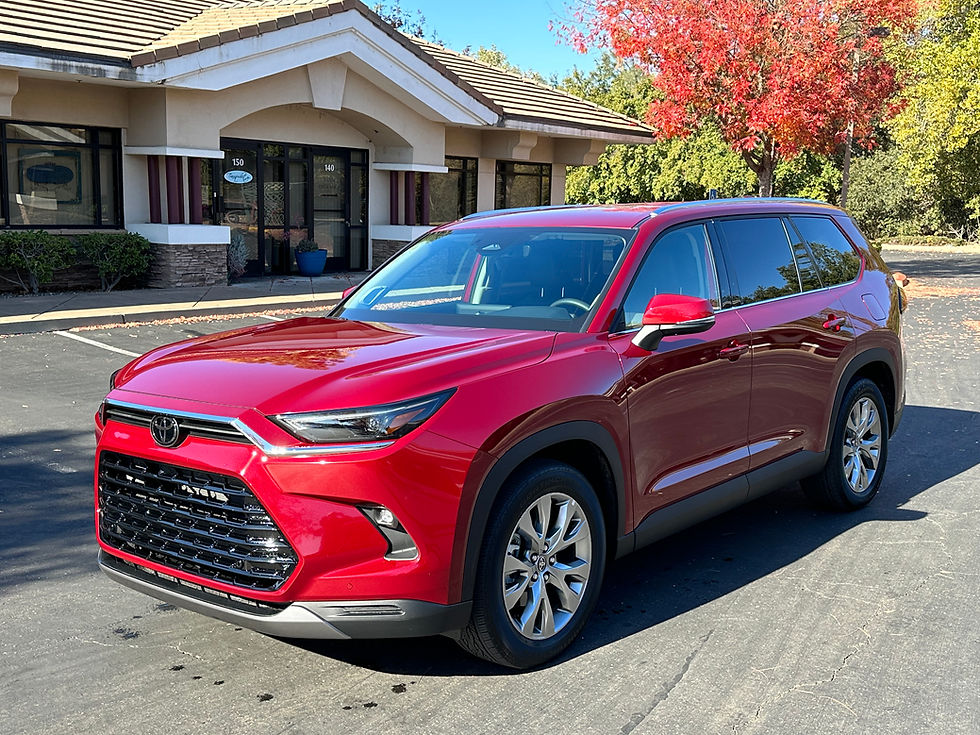Aimed at the Heart of the Mainstream: The 2023 Honda Pilot
- Mike Hagerty

- Mar 21, 2023
- 3 min read
Updated: Dec 31, 2024

After three generations of "hit 'em where they ain't", Honda has decided to put the 2023 Pilot into the thick of the three-row SUV battle. The gently curving, sleek look introduced in 2016 is out, replaced by sharp angles and character lines intended to make the Pilot look they way Americans seem to like their SUVs---big, blocky and brawny.

Honda says the new Pilot is the largest and most powerful Honda SUV ever. How large? Three inches longer, one inch wider and one inch taller than the Kia Telluride. And to be honest, that was probably the target.
The Kia, which has become the Pilot's closest competitor in sales (both run far behind Toyota Highlander and Ford Explorer), is a midsize SUV large enough that a fellow automotive journalist confused it for a full-size in a Facebook conversation I had with him the other day (true full-size SUVs are about ten inches longer). It also beats the Telluride in ground clearance by a tenth of an inch---8.1 to 8.0, a number that takes on a bit more importance now that Pilot has its own off-road oriented TrailSport trim.


How powerful? The displacement hasn't changed, but the Pilot has an all-new 3.5-liter V6. It's packing 285 horsepower---up five from the old one. Torque is unchanged at 262 lb-ft. The old nine-speed automatic transmission is gone---replaced by a ten-speed. There's an improvement in fuel economy, though in TrailSport models, like our tester, that gets largely eaten by the off-road tires and compromised aerodynamics from the slightly-lifted suspension. The EPA combined city/highway estimate for the Pilot TrailSport is 20 mpg. More street-oriented Pilots get 22.

If you have to have all three rows of seating in place, cargo room in the new Pilot can't quite match that of the Kia---18.6 cubic feet to 21.0. But fold the third row in both and the advantage goes to Honda---48.5 cubic feet to 46.0. If you can do with only the two front seats for people, both vehicles max out at 87.0 cubic feet.



The new Pilot can't quite edge out the Telluride when it comes to interior space for people, though. Folks in the Honda's front row get half an inch less of legroom than those in the Kia. There's 2.8 inches less legroom for second-row passengers in the Pilot, though there is an extra 1.2 inches of rear headroom.

The '23 Pilot gets treated to a complete interior makeover with a new, less cluttered dash, clearly using the same basic design language as the new Accord and Civic instrument panels.
Honda has priced the Pilot above the Telluride. The base FWD Sport model ends up over $40,000 with destination, giving Kia a roughly $3,000 price advantage. The tab for our tester, the AWD TrailSport, is even heftier, with a base price (including destination) of $49,645. But when you get to the off-road oriented Tellurides (X-Line and X-Pro), the advantage evaporates. Those vehicles start just above $50,000 with destination.
The Pilot does give you a lot for the money---in the case of the TrailSport, integrated drive modes including snow and trail/sand modes, hill start assist and hill descent control, along with a leather-wrapped heated steering wheel, nine-speaker audio system, wireless phone charger, wireless Apple CarPlay and Android Auto, Cabin Talk (an intercom so the driver can talk to the third row passengers without yelling), tri-zone automatic climate control, heated front seats, second-row sunshades, a panoramic moonroof, 18-inch wheels, LED fog lights, a heated windshield, remote engine start and Honda's comprehensive Honda Sensing active safety suite.



And the good news with Honda's pricing scheme is it's all-inclusive. The only option on our test vehicle was Sonic Gray Pearl paint ($395). That puts the as-tested price at $50,040.



There's no question the battle for supremacy among mid-size three-row SUVs is brutal. The 2023 Honda Pilot is in a much better position than the old model for the next few rounds.





